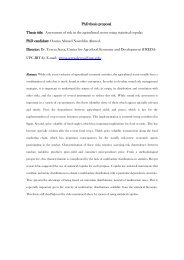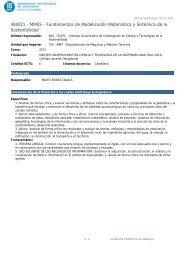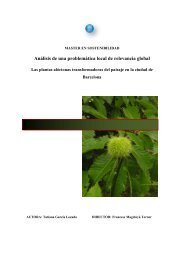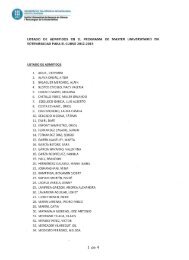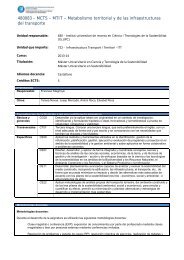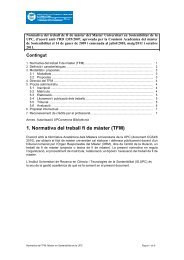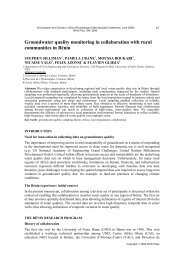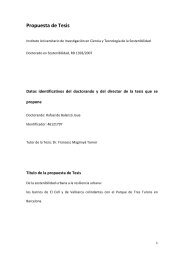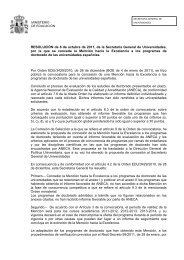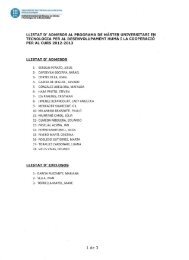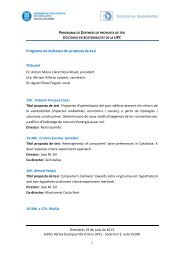âConsumer's behavior towards extra virgin olive oil: hypothetical and ...
âConsumer's behavior towards extra virgin olive oil: hypothetical and ...
âConsumer's behavior towards extra virgin olive oil: hypothetical and ...
You also want an ePaper? Increase the reach of your titles
YUMPU automatically turns print PDFs into web optimized ePapers that Google loves.
atPolitècnica deCatalunyaUniversitat Politècnica de CatalunyaInstitut de SostenibilitatPh.D. Thesis ProposalAcademic Year2012-2013“Consumer’s <strong>behavior</strong> <strong>towards</strong> <strong>extra</strong> <strong>virgin</strong> <strong>olive</strong> <strong>oil</strong>:<strong>hypothetical</strong> <strong>and</strong> non-<strong>hypothetical</strong> discrete choiceexperiment methods”Thesis proposal to be submitted to the Institut de SostenibilitatUniversitat Politècnica de CatalunyaByAhmed YANGUI 1Under the supervision ofThesis director: Prof. José María GilCo-director: Dr. Montserrat Costa-FontPhD Program: SustainabilityMain Subjects: Agricultural Economics <strong>and</strong> Applied economics1 Ahmed YANGUIPhD student at CREDA-UPC-IRTAParc Mediterrani de la TecnologiaEdifici ESAB. C/ Esteve Terrades, 8E-08860 Castelldefels [Barcelona]Tel. +34 93-552- 1208e-mail: ahmed.yangui@upc.edu1
Ph.D. Thesis ProposalAcademic Year2012-2013“Consumer’s <strong>behavior</strong> <strong>towards</strong> <strong>extra</strong> <strong>virgin</strong> <strong>olive</strong> <strong>oil</strong>:<strong>hypothetical</strong> <strong>and</strong> non-<strong>hypothetical</strong> discrete choiceexperiment methods”Thesis proposal to be submitted to the Institut de SostenibilitatUniversitat Politècnica de CatalunyaByAhmed YANGUIUnder the supervision ofThesis director: Prof. José María GilCo-director: Dr. Montserrat Costa-FontPhD Program: SustainabilityMain Subjects: Agricultural Economics <strong>and</strong> Applied economics2
1. IntroductionSince the introduction of discrete choice experiments by Louviere <strong>and</strong> Hensher (1982)<strong>and</strong> Louviere <strong>and</strong> Woodworth (1983) it has been used by a growing number of studies.Discrete choice experiments are appealing as value derivation techniques because theyare consistent with both Lancaster’s microeconomic approach (Lancaster, 1966) <strong>and</strong>R<strong>and</strong>om Utility Theory (RUT) (McFadden, 1974). In the other words, Discrete choicemethods assume that individuals are rational <strong>and</strong> make choices to maximize their utilitytaking into account budget constraint, <strong>and</strong> their utility derived from the differentcharacteristics, or attributes, that a good possesses, rather than directly from the goodper se. Accordingly, a change in the level of an attribute describing a given alternativegood may cause respondent to favor that good over another that is perceived asproviding an inferior combination of attributes.In discrete choice experiments, respondents are asked to select their preferredalternative from a given set (the choice set), <strong>and</strong> are typically asked to perform asequence of such choices giving rise to a panel of discrete choices. Experimental designtheory is used to construct the alternatives, which are defined in terms of both theirattributes <strong>and</strong> the levels that these attributes could take (see Louviere et al., 2000 <strong>and</strong>Street <strong>and</strong> Burgess, 2007).Despite the widespread use of discrete choice experiments, evidences presented innumerous papers indicate the existence of related various issues based on therepresentative level of the sample (widely <strong>and</strong> limit sample size), preference type (statedpreferences, revealed preference), empirical setting (<strong>hypothetical</strong> <strong>and</strong> non-<strong>hypothetical</strong>situation), the selected model for the estimation (regression, logit, probit, hierarchicalBayes), the type of inference estimation procedures (maximum likelihood, Markov1
chain Monte Carlo) <strong>and</strong> finally the extend of the design (full factorial, fractionalfactorial, adaptive).If considering the estimation modeling, the most recently adopted <strong>and</strong> reported in theliterature is the one based in r<strong>and</strong>om utility theory <strong>and</strong> named R<strong>and</strong>om Parameter Logitmodel (RPL). Since its introduction by Train (1998) many works noticed the greatrelevance of the model such as Scarpa <strong>and</strong> Giudice( 2004) <strong>and</strong> Menapace et al. (2011).In fact the RPL model has evolved as a fundamentally useful tool in the analysis ofdiscrete choice models. The RPL model in contrast to other more simple specificationssuch as the multinomial logit model allows for a more flexible <strong>and</strong> continuous form ofpreference heterogeneity. The multinomial model assumes preferences homogeneity inthe sample, implying that all coefficient of the utility expression are the same acrossindividuals, whereas the RPL model allows utility coefficients vary across individualsaccording to continuous probability distribution functions (Train, 1998). However, theRPL model also presents some limitations. Being the most important a potential weakheterogeneity among participants derived from the fact that individual partworth acrossthe participants could be very similar Consistently with Akaichi et al. (2013), ther<strong>and</strong>om parameter logit model predicts better when sample mean partworth of thecoefficients are used for model predictions than the hierarchical Bayesian multinomiallogit model. Hence, the possibility of estimating deep parameters to account for newsources of heterogeneity could be having great relevance.Individuals choices are part of a decision making process of interest to many scholarsincluding economist, marketers, <strong>and</strong> planners. Therefore the basic RUT whereindividual’s utility is assumed to be a function of a set of explanatory variables thatdefine the product could be very restricted <strong>and</strong> an extension of this model will bepertinent. The extensions can be achieved by: 1) the addition of a flexible disturbance in2
order to allow for a rich covariance structure <strong>and</strong> enable the estimation of unobservedheterogeneity through, r<strong>and</strong>om parameters or relaxing the IIA condition of the logit; 2)by developing specific models of latent psychological explanatory variable that conformthe individuals decision making process such as attitudes <strong>and</strong> perceptions in order toprovide a richer underst<strong>and</strong>ing <strong>and</strong> explanation of individuals’ <strong>behavior</strong>; 3) by theinclusion of a latent segmentation of the population (latent class) captured by means oftaste parameters, choice sets, <strong>and</strong> decision protocols; <strong>and</strong> finally 4) by combiningrevealed preferences <strong>and</strong> stated preferences so as to reduce bias <strong>and</strong> improvingefficiency of the parameter estimates (Walker <strong>and</strong> Ben-Akiva, 2002). These extensionsincorporated in RUT are able to provide insights into the individual’s decision makinganalysis which are considered by the basic model as the “Black box”.A key objective of discrete choice experiment is to obtain sufficient quantity of highquality choice data to estimate the appropriate choice models to be used to explorevarious relevant issues. However, the basic choice experiment consist in askingrespondents to choose the more preferred of various alternatives offered in choice set,thereby obtaining one choice observation per set. Generally there are two traditionalways to increase the number of observations either by increasing the sample size orincreasing the number of choice sets evaluated by each respondent. The former clearlyhas cost implications, especially when the real incentives are used, while the latter canimpose difficulties in the task of respondents (Lancsar et al., 2013).More recently, two new ways for choice experiment question formulation wereproposed named Ranking Conjoint Analysis (RCA) <strong>and</strong> Best Worst Scaling (BWS).The first ask respondent to express preferences for several alternatives existing in thechoice set by ranking them from more preferred to less preferred, while the second askrespondent to choose not only the best option in each choice set, but also the worst3
option respect to the remaining options (Louviere, 2008). These two methods imply anincrease of questions per choice set instead of an increase of the number of choice set.In addition, it provides information about the relative preference of respondent’s relatedto the non-chosen profiles of the basic choice experiment. It’s important to highlightthat the combination of these experimental methods (RK <strong>and</strong> BWS)with an appropriateexperimental design for the <strong>extra</strong> choice information could be used to estimate modelsfor single individuals providing a new way to capture heterogeneity (Caparros et al.,2008; Akaichi et al., 2013). Moreover, it allow us to obtain a ranking for thealternatives that constitute the choice showing the gradation from the most preferred<strong>and</strong> the less preferred option by individual in the BWS method (Lancsar et al., 2013).Consequently, it remains to be of great relevance to test the predictive power of theRanking Discrete choice experiment <strong>and</strong> the Best Worst Scaling methods forindividuals’ real world actions adopting efficient experimental design.This thesis try to overcome the limitations above mentioned in the literature by meansof both methodological <strong>and</strong> empirical innovations in nature especially in the agro-foodmarketing sector. Its scientific contributions are organized in three main chaptersdefining three independent scientific articles. The analysis of consumer’s preferenceheterogeneity <strong>towards</strong> traditional product such as <strong>extra</strong> <strong>virgin</strong> <strong>olive</strong> <strong>oil</strong> is the guidelineof this thesis. The purpose of the first chapter consists in the possibility to identifyadditional <strong>behavior</strong>al information associated with consumer’s preference heterogeneityby the application of an extended R<strong>and</strong>om Parameter Logit Model. Following Greene elal. (2006) we explore the further impact of accounting for the mean <strong>and</strong> varianceheterogeneity in the distribution of individual specific preferences. Under a widelyunderst<strong>and</strong>ing of consumer’s decision making close to traditional product, the secondapproach incorporate several elements of cognitive process that have been identified as4
important including strong dependence to the choice process. This analysis relies on theintegration of latent variables that define consumer’s personality trait <strong>and</strong> lifestyleorientation in their utilities function. In doing so, we cover an important research gap bythe application of a flexible <strong>and</strong> practical hybrid choice model (Ben-Akiva et al., 2002.Finally, the third part represents our work plan for the last article. A brief description ofeach one is offered below.2. Revealing additional preference heterogeneity with extent R<strong>and</strong>omparameter logit model: The case of <strong>extra</strong> <strong>virgin</strong> <strong>olive</strong> <strong>oil</strong> for Catalanconsumer’s.In the past times, different preference elicitation methods have been used by economists<strong>and</strong> market researchers to obtain the willingness to pay (WTP) for definite productattributes. Among the preference elicitation methods, discrete choice experiment hasbeen widely used in the literature. On the other h<strong>and</strong>, methods to model preferenceheterogeneity in discrete choice experiment continue to receive a significant attention inthe literature. These models include the Latent Class Model (LCM), R<strong>and</strong>omParameters Model, etc.The growing popularity of RPL model to obtain estimates of WTP has focused in therelaxation of the three limitations of the conventional logit model such as multinomiallogit model (MNL) or conditional logit model (CL). Firstly, it allows us to expectr<strong>and</strong>om preference variation across the population through the distribution of ther<strong>and</strong>om parameters. Secondly, the RPL relax the assumption of the independence fromirrelevant alternatives (IIA). Finally, this model allows the correlation amongunobserved factors over time (Train, 2003). However, the RPL present a majorlimitation. The partworth for ith individualis the sum between the sample-meanpartworth <strong>and</strong> the st<strong>and</strong>ard deviation of the distribution of around5
, which is influenced by the individual specific heterogeneity with mean zero<strong>and</strong> st<strong>and</strong>ard deviation one as follow: (Hensher <strong>and</strong> Greene, 2003).Therefore, if the quantityis so small so the individual partworth acrossrespondents will be very similar.For that reason, through the present study we enhance the RPL following (Greene et al.,2006) by estimating deep parameters to account for heterogeneity around the means <strong>and</strong>the variances of the r<strong>and</strong>om parameters distributions. However the possibility exists toadd further <strong>behavior</strong>al information associated with the mean <strong>and</strong> the variance of ther<strong>and</strong>om parameter distribution, through parameterization of its heterogeneity as follow:. Where the vector is a set of choice invariantcharacteristics that produce individual heterogeneity in the means,are parameterswhich capture the mean shift, is specified as [ ]. Where areparameters which capture variance heterogeneity of the r<strong>and</strong>om parameters in thesystematic utility <strong>and</strong>are observed variables of the individuals.This last aspect is the main contribution of this paper for the food marketing literature.The performance of the Greene et al. (2006)’s GHR-RPL model is evaluated against CL<strong>and</strong> RPL models. This models has been applied for assess of the preferenceheterogeneity of Catalan consumer <strong>towards</strong> the consumption of the <strong>extra</strong> <strong>virgin</strong> <strong>olive</strong><strong>oil</strong>. This product has been chosen, firstly, for his economic importance, already Spain isthe world leader as producer country <strong>and</strong> as exporter of <strong>olive</strong> <strong>oil</strong>. Secondly, that <strong>extra</strong><strong>virgin</strong> <strong>olive</strong> <strong>oil</strong> is the fundamental component in the Spanish diet.In order to achieve these objectives, a sample of 401 consumers of <strong>extra</strong> <strong>virgin</strong> <strong>olive</strong> <strong>oil</strong>was used. Data was collected via face-to-face interviews in Catalonia during September2009, in different shopping hours <strong>and</strong> at different type of food retail store. The survey is6
divided in three blocks. The first block was designed to elicit information about sociodemographic <strong>and</strong> respondents’ lifestyles. The second block consists of a choiceexperiment, where four main attributes were identified each defined with three levels:price (3.70 €/l, 6 €/l, <strong>and</strong> 7.5 €/l), production system (conventional, protecteddenomination of origin (PDO), <strong>and</strong> organic), origin of the product (Spain, Catalonia,<strong>and</strong> Imported) <strong>and</strong> origin of the br<strong>and</strong> (Spanish, Catalonia, <strong>and</strong> distribution br<strong>and</strong>).Finally, the third block was focused on respondents’ <strong>olive</strong> <strong>oil</strong> <strong>and</strong> organic <strong>olive</strong> <strong>oil</strong>buying <strong>and</strong> consumption habits as well as purchasing attitudes.Finally, as principal results we can cite, taking into account the heterogeneity within ther<strong>and</strong>om parameters, results in a better model fit for most of cases. Obtaining similarutility distributions compared with the RPL with higher st<strong>and</strong>ard deviation due the newsource of heterogeneity detected. Unfortunately, in line with Greene et al. (2006) thisprocedure is possible to produce unacceptable ranges in the <strong>behavior</strong>al outputs,including the sensible outputs in terms of sign. Despite that all the parameters estimatedwith the GHR-RPL have maintained their evaluated signs except the interaction factorCONV*CAT (conventional <strong>extra</strong> <strong>virgin</strong> <strong>olive</strong> <strong>oil</strong> with Catalan origin), two samplemean-partworth of the factors PDO, <strong>and</strong> interaction factor ORG*ESP (organic <strong>olive</strong> <strong>oil</strong>with Spanish origin) lost their significance although their st<strong>and</strong>ards deviation continueto be statistically significant.Secondly, the most relevant attribute that determines respondents’ election <strong>towards</strong><strong>extra</strong> <strong>virgin</strong> <strong>olive</strong> <strong>oil</strong> is origin <strong>and</strong> specifically the Catalan origin of the product incontrast to the Spanish or imported origin. Results show that organic production of <strong>extra</strong><strong>virgin</strong> <strong>olive</strong> <strong>oil</strong> is negatively valued by respondents <strong>and</strong> the protected denomination oforigin characteristic positively valued although is not statistically significant. Thirdly,The GHR-RPL results reveal that the preference intensities for <strong>olive</strong> <strong>oil</strong> with PDO is7
affected negatively by the terms subjective norms (NSB). In contrast, the termsenvironment concerns <strong>and</strong> subjective norm moderate the negative preference associatedto organic production. Furthermore purchase intention, subjective norms <strong>and</strong> the higherlevel of study could mitigate the sensitivity of the consumers respect to price. Finally,when the purchase frequency will be more separate this will mitigate the negativepreference associated with Spanish organic <strong>olive</strong> <strong>oil</strong>.3. The effect of food related personality traits <strong>and</strong> lifestyle orientation onconsumer’s behaviour related to <strong>extra</strong> <strong>virgin</strong> <strong>olive</strong> <strong>oil</strong>: estimation of anextended hybrid choice model.Choice models have displayed to be of high value <strong>and</strong> importance in a wide variety ofapplied settings such as agro food marketing, public goods valuation, transport analysis,etc. (Van Loo et al., 2011; Greene <strong>and</strong> Hensher, 2013; etc.). The employment ofexperimental choice models has been motivated by the combination of two principalfeatures: (1) realism: in real markets, consumers are faced with competing products <strong>and</strong>must choose among them, <strong>and</strong> (2) experimental control (Ashok et al., 2002). Discretechoice modelling defines individuals’ utility function by means of explanatory variablessuch as the socio-economic characteristics of respondents <strong>and</strong> product attribute levels.However, in the last decade, many works have noticed that decision makers areconditioned by their psychological factors, personality traits, attitudes, etc. (Chen, 2007;Yáñez et al., 2010). These last concepts cannot be directly measures but inferred fromobserved variables. Therefore, our work focuses on the incorporation of latent variablessuch as attitudes <strong>and</strong> perceptions as explanatory variables in discrete choice models.Hybrid choice model (HCM) represents a promising new class of models which mergeclassic choice models with structural equations models (SEM) for latent variables (LV).Regardless of their conceptual appeal, up to date the application of HCM in agro food8
marketing remains very scarce. The present work extends previous HCM applicationsby first estimating a r<strong>and</strong>om parameter logit model (RPL) into panel data context(taking into account the heterogeneity around the mean) <strong>and</strong> second, estimating therelationships between latent variables. Moreover, few studies have investigated thepotential effect of purchase habits, food-related personality traits <strong>and</strong> lifestyleorientation on consumer’s <strong>behavior</strong> (Chen, 2007; Eertmans et al., 2005). However,neither work try to underst<strong>and</strong> which effect they have on the consumers’ <strong>behavior</strong>related to organic <strong>olive</strong> <strong>oil</strong> <strong>and</strong> to the <strong>extra</strong> <strong>virgin</strong> <strong>olive</strong> <strong>oil</strong> (EVOO) in general asSpanish traditional product. The model pretends to better underst<strong>and</strong> Catalanconsumer’s behaviour <strong>towards</strong> <strong>extra</strong> <strong>virgin</strong> <strong>olive</strong> <strong>oil</strong>. Therefore, in order to ascertain therole of psychological factors in consumer’s behavioural process of decision <strong>towards</strong> atraditional product, variables such as food related personality traits, purchase habits <strong>and</strong>lifestyle orientation were introduced. With especial attention to the relationship betweenthem <strong>and</strong> the factors determinant of consumer’s purchase intention, based in the theoryof planned <strong>behavior</strong> (TPB).As above mentioned, the Data used here corresponds to a survey carried out on arepresentative sample of Catalonian population with quotas by postal code. The initialsample consisted of 425 face-to-face interviews from which 401 answered the choiceexperiment. Data were conducted in September 2009 at different shopping hours <strong>and</strong>different types of food retail stores. To implement CE, first, attribute <strong>and</strong> attribute levelswere determined based on a three-step procedure: 1) Literature review regardingconsumer <strong>behavior</strong> of <strong>extra</strong> <strong>virgin</strong> <strong>olive</strong> <strong>oil</strong>; 2) four focus groups of 8 people each toidentify main consumption patterns <strong>and</strong> attitudes <strong>towards</strong> <strong>extra</strong> <strong>virgin</strong> <strong>olive</strong> <strong>oil</strong>, withspecial attention respect the organic attribute; <strong>and</strong> 3) observation in retails outlets toidentify real prices <strong>and</strong> informal interviews about reasons of choosing a specific9
product. Therefore, four main attributes were identified each defined with three levels:price (3.70 €/l, 6 €/l, <strong>and</strong> 7.5 €/l), production system (conventional, protecteddenomination of origin (PDO), <strong>and</strong> organic), origin of the product (Spain, Catalonia,<strong>and</strong> Imported) <strong>and</strong> origin of the br<strong>and</strong> (Spanish, Catalonia, <strong>and</strong> distribution br<strong>and</strong>).The findings suggest that the incorporation of inferred LV for underst<strong>and</strong>ingindividuals’ food decision making constructions is needed. That is, some LV haveindirect effects associated with consumer’s purchase intention <strong>towards</strong> organic <strong>olive</strong> <strong>oil</strong>,<strong>and</strong> that almost all LV considered have a direct effect related to consumer’s utilitiesassociated with <strong>extra</strong> <strong>virgin</strong> <strong>olive</strong> <strong>oil</strong>. The results reveal a high <strong>and</strong> significantheterogeneity, highlighting the role of the housewife with high level school education asresponsible of both household food purchases <strong>and</strong> preparation of familiar dishes.Unexpected finding proves that healthy lifestyle was not a significant explicative latentvariable in forming consumers’ attitude <strong>towards</strong> <strong>extra</strong> <strong>virgin</strong> organic <strong>olive</strong> <strong>oil</strong>. This canbe due to cultural reasons, the <strong>extra</strong> <strong>virgin</strong> <strong>olive</strong> <strong>oil</strong> is a traditional component of theSpanish <strong>and</strong> Catalan diet <strong>and</strong> already perceived as a healthy food product. On the otherh<strong>and</strong>, the health <strong>and</strong> natural content of it could explain the positive effect of foodinvolvement.Our result support the contention that attitudes, personality traits <strong>and</strong> lifestyleorientation are helpful in food choice <strong>and</strong> important variables to reveal the ambiguityassociated with consumer’s <strong>behavior</strong>al process. However, the principal limitation of thiswork is the lack of available software tools enable to estimate simultaneously the hybridchoice model taking into account the introduction of correlation among the individuals.10
4. Ranking <strong>and</strong> Best Worst discrete choice experimentFrom time to time since Thrustone (1927) developed the R<strong>and</strong>om Utility Theory (RUT),many authors such as Louviere et al. (1999) have discussed various ways to collectindividuals’ responses consistent with RUT. They show how various response formscan be used to obtain <strong>extra</strong> choice information that can be exp<strong>and</strong>ed into impliedchoices. It is fair to say that most researchers believe that 1) one would need to observemany choice sets for each person in a survey to insure that each individual-level discretechoice model would successfully converge <strong>and</strong> yield reliable estimates, <strong>and</strong> 2) thenumber of choice sets required would be too large for typical survey applications(Louviere el al., 2008).To obtain more preference information, some researchers obtained a full rank-orderingof the alternatives in particular choice sets simply asking a respondent to state providepartial rankings. Typically, this ranking was for one or a small number of sets, <strong>and</strong> theapplications of a full or partial ranking of the alternatives in each choice set could becombined with an optimally efficient design for multiple choices set to providesufficient choice observation to estimate models for individuals. Louviere et al. (2008)commented that maybe is true that asking an individual to rank a set of option isequivalent to asking her to make repeated preference choices from a set of options, suchas most preferred, least preferred, next most preferred, etc. Furthermore, according toMarley <strong>and</strong> Louviere (2005), best worst tasks seem to be easier to respond for peoplethan to complete a traditional ranking task that is it takes advantage of a person’ssusceptibility to identify <strong>and</strong> respond more consistently to extreme options. If that istrue, normally the predictive power of sequential best worst task for individual’s realaction will be better that to the ranking task.11
Given the importance of this topic for marketing, environmental <strong>and</strong> agricultureeconomics, we conducted our experiments: 1) in non-<strong>hypothetical</strong> conditions toovercome the <strong>hypothetical</strong> bias problem, <strong>and</strong> 2) to follow the estimation of partworthsby an external validity analysis (holdout task) to see if the estimates parameters actuallywork in predicting significant real world actions. Therefore, our study st<strong>and</strong>s out by theinclusion of non-<strong>hypothetical</strong> holdout choice task in both ranking (RK) <strong>and</strong> best worst(BW) discrete choice experiment methods which allowed us to assess <strong>and</strong> compare theexternal predictive performance of the estimated parameters in both methods.To attend this main objective a r<strong>and</strong>om sample of 120 of <strong>olive</strong> <strong>oil</strong> consumers will beselected to evaluate different alternatives of the <strong>olive</strong> <strong>oil</strong> through different choice sets.The individuals will be equally assigned to two discrete choice experiment methods (60persons per mechanism). The different alternatives were defined through thecombination of the four attributes <strong>and</strong> their levels, the type of the <strong>olive</strong> <strong>oil</strong> (<strong>extra</strong> <strong>virgin</strong>,<strong>virgin</strong>, refined), the origin (Andalucía, Catalonia, any other Spanish regions), the br<strong>and</strong>(private label, manufacturer label), <strong>and</strong> the price (2.20, 3.50, <strong>and</strong> 4.80 Euro/L). Street<strong>and</strong> Burgess’s (2007) D-optimally efficient design was used to identify nine choice setswith five different <strong>olive</strong> <strong>oil</strong>s <strong>and</strong> “none of them” option for each.Individuals will be asked either to rankthe alternatives from most preferred to leastpreferred, or to apply a sequential best worst mechanism (e.g. best from the 5alternatives, worst from the remaining 4 alternatives, the best of the remaining 3alternatives, <strong>and</strong> the worst of the remaining 2 alternatives) taking into account theirregular purchase habit (see figure 1 <strong>and</strong> figure 2). Afterword, to finish all nine choicesets, each person we will be presented with a hold out choice set (figure 3). Each personshould be chosen between 10 different <strong>olive</strong> <strong>oil</strong>s <strong>and</strong> the “none of them” option. Sincethe data base will be collected, different models will try to estimate consumer’s12
preferences such as the “rank ordered logit”, the “sequential best worst multinomialmodel”, <strong>and</strong> the “R<strong>and</strong>om parameter logit”.5. Work planThe thesis is beig developing under the supervision of prof. José María Gil <strong>and</strong> Dr.Montserrat Cost-Font at CREDA-UPC-IRTA. A summary of the work done up to now<strong>and</strong> a proposed work plan for the completion of the thesis is offered below.The first part of this thesis, which focuses in revealing additional preferenceheterogeneity of Catalan consumers of <strong>extra</strong> <strong>virgin</strong> <strong>olive</strong> <strong>oil</strong>with <strong>and</strong> extendedR<strong>and</strong>om Parameter logit model, has been already completed. A research paper (Yanguiet al., 2012) derived from this part, has been recently submitted for publicationconsideration in the Journal of Agriculture Economics, a journal with ISI Impact Factor(1.551). The paper (Yangui et al., 2013) has been also presented at the “AgricultureEconomic Society Annual Conference” in April 8-10, 2013.The second scientific article of the thesis, which aims to assess the effect of food relatedpersonality traits <strong>and</strong> lifestyle orientation on consumer’s behaviour related to <strong>extra</strong><strong>virgin</strong> <strong>olive</strong> <strong>oil</strong> with the application of an extended hybrid choice model, has beenalready finished. A research paper (yangui et al., 2013) containing the results of thissecond part will be soon submitted for publication consideration in the Journal ofAgricultural <strong>and</strong> Resource Economics, a journal with ISI Impact Factor (0.71). Also,the paper (Yangui et al., 2013) has been recently sent for consideration as acommunication at the African Agriculture Economic Association conference (AAEA)which will be celebrated in Tunisia, September 22–25, 2013.The work during this period will be devoted to prepare the third part of the thesis <strong>and</strong> tocomplete the whole version of this doctoral thesis. Currently, an empirical experiment is13
eing developed to collect the necessary data base, <strong>and</strong> forthcoming models will beestimated.6. ReferencesAkaichi, F., R. M. Nayga, Jr. <strong>and</strong> J. Gil. “Are Results from Non-Hypothetical Choice-Based Conjoint Analysis <strong>and</strong> Non-Hypothetical Recoded-Ranking ConjointAnalysis Similar?” Forthcoming in American Journal of Agricultural Economics(early 2013)Ashok, K., Dillon, W., Yuan, S., (2002) “Extending discrete choice models toincorporate attitudinal <strong>and</strong> other latent variables”, Journal of Marketing ResearchVol. 39, 31-46.Ben-Akiva, M., McFadden, D., Train, K., Walker, J. Bhat, C.a, Bierlaire, M., Bolduc,D., Börsch-Supan, A., Brownstone, D., Bunch, D.S., Daly A., De Palma, A.,Gopinath, D., Karlstrom, A., <strong>and</strong> Munizaga, M.A., (2002) “Hybrid choice models:Progress <strong>and</strong> challenges”, Marketing Letters, 13, 3, 163-175.Caparrós A., Oviedo, J.L <strong>and</strong> Campos, P. 2008. Would you choose your preferredoption? Comparing choice <strong>and</strong> recoded ranking experiments. American Journal ofAgricultural Economics 90, 3, 843-855.Chen, M. F. (2007) “Consumer attitudes <strong>and</strong> purchase intentions in relation to organicfoods in Taiwan: Moderating effects of food-related personality traits.” Foodquality <strong>and</strong> preference 18, 7, 1008-1021.Eertmans, A., Victoir, A., Vansant, G., <strong>and</strong> Van den Bergh, O. (2005) “Food-relatedpersonality traits, food choice motives <strong>and</strong> food intake: Mediator <strong>and</strong> moderatorrelationships”, Food Quality <strong>and</strong> Preference, 16, 714.14
Greene, W.H., <strong>and</strong> Hensher, D.A. (2013) “Revealing additional dimensions ofpreference heterogeneity in a latent class mixed multinomial logit model” AppliedEconomics 45, 14, 1897.Greene, W.H., Hensher, D.A., (2007). “Heteroscedastic control for r<strong>and</strong>om coefficients<strong>and</strong> error components in mixed logit” Transportation Research E, 43, 75–92.Greene, W.H., Hensher, D.A., Rose, J., (2006). “Accounting for heterogeneity in thevariance of unobserved effects in mixed logit models”. Transportation Research B4, 1, 75–92.Hensher, D.A., Greene, W.H., (2003). “Mixed logit models: state of practice”.Transportation 30, 2, 133-176Hensher, D.A., Greene, W.H., (2003). “Mixed logit models: state of practice”.Transportation 30, 2, 133-176.Lancaster, K. J. (1966), “A new approach to consumer theory”, The journal of politicaleconomy, 74, 2, 132-157.Lancsar, E., Louviere, J., Donaldson, C., Currie, G., <strong>and</strong> Burgess, L. (2013) “Best worstdiscrete choice experiment in health: Methods <strong>and</strong> an application” Social Science<strong>and</strong> Medicine 76, 74-82.Louviere JJ & Woodworth GG (1983) “Design <strong>and</strong> analysis of simulated choice orallocation experiments: an approach based on aggregate data”. Journal ofMarketing Research 20: 350-367.Louviere, J., Street, A., Burgess, L., Wasi, N., Islam, T., & Marley, A. (2008).Modeling the choices of individual decision-makers by combining efficient choice15
experiment designs with <strong>extra</strong> preference information. The Journal of ChoiceModelling, 1, 128-163.Louviere, J.J. <strong>and</strong> Street, D. (2000). “Stated-preference Methods” in David A Hensher& Kenneth J Button (eds), H<strong>and</strong>book of Transport Modelling, Pergamon Press,Amsterdam, Netherl<strong>and</strong>s, 131-143.Louviere, J.J. <strong>and</strong> Hensher D.A. (1982) “On the design <strong>and</strong> analysis of simulated orallocation experiments in travel choice modeling”. Transportation ResearchRecord 890:11-17.Louviere, J.J., Hensher D.A., <strong>and</strong> Swait, J. (1999) “Conjoint analysis methods in thebroader context of preference elicitation methods. In Gustafson, A., Herman, A.,Huber, F. (eds), Conjoint measurement: Methods <strong>and</strong> Applications, 279-318.Springer, Berlin.Marley, A., <strong>and</strong> Louviere, J. (2005) “Some probabilistic models of best, worst, <strong>and</strong> bestworstchoices” Journal of Mathematical Psychology, 49, 6, 464-480.McFadden, D. (1974), “Conditional logit analysis of qualitative choice <strong>behavior</strong>”, EnZarembka, P. (ed.) Frontiers in econometrics. Academic press, Nueva York.Menapace, L., Colson, G., Grebitus, C. <strong>and</strong> Facendola, M. (2011), “Consumers’preferences for geographical origin labels: evidence from the Canadian <strong>olive</strong> <strong>oil</strong>market”, European Review of Agricultural Economics 38, 2, 193–212.Scarpa, R. <strong>and</strong> Del Guidice, T. (2004), “Market segmentation via mixed Logit: <strong>extra</strong><strong>virgin</strong><strong>olive</strong> <strong>oil</strong> in urban Italy” Journal of Agriculture <strong>and</strong> Food IndustrialOrganization, 2, 1-18.Street, D. & Burgess, L.B. (2007). “The Construction of Optimal Stated ChoiceExperiments: Theory <strong>and</strong> Methods”, 1, John Wiley <strong>and</strong> Sons, Hoboken, NewJersey.16
Thrustone, L.L., (1927) “A law od comparative judgment” Psychological Review 34,273-286.Train, K., (1998). “Recreation dem<strong>and</strong> models with taste differences over people”. L<strong>and</strong>Economics 74, 185-194.Train, K., (2003). “Discrete Choice Methods with Simulation”. Cambridge UniversityPress, Cambridge.Van Loo, E. J., Caputo, V., Nayga Jr., R. M., Meullenet, J. F. <strong>and</strong> Ricke, S. C. (2011),“Consumers’ willingness to pay for organic chicken breast: Evidence from choiceexperiment”, Food Quality <strong>and</strong> Preference, 22, 603.Walker, J., <strong>and</strong> Ben-Akiva, M. (2002) “Generalized r<strong>and</strong>om utility mode” MathematicalSocial Sciences, 43, 303-343.Yañez, M.F., Raveau, J. <strong>and</strong> Ortúzar, J.D. (2010) “Inclusion of latent variables in MixedLogit Models: Modelling” Transport research part A, 44, 744.17
السبت ١٨ من جمادى الأولى ١٤٣٤ه الموافق ٣٠ من مارس ٢٠١٣م العدد ١١٦٢٤Saturday 30 March 2013 Edition No1162420حملة تنظيف الشعب المرجانية والشواطئ في مرباط تهقق أهدافهاالاستعانة بغواصين كبار يوءدي إلى تقدم ملهوظ بعمليات المسه والتقييماستخراج كميات كبيرة من الأكياس البلاستيكية والمخلفاتالمفوض لا يفوض !علي بن راشد المطاعنيalimatani2@اعضاء الهملة على شاطي ايلينيتصلالة- غانم العمرياختتمت أمس الأول حملة لتنظيف الشعبالمرجانية والشواطئ في ولاية مرباط التيحققت أهدافها بنجاه كبير حيش استهدفتتنظيف الشعب المرجانية والشواطئ منمخلفات شباك الصيد والملوثات البهريةالاخرى.وقد شارك في الهملة التي نظمتها المديريةالعامة للبيئة والشوءون المناخية بمهافظةظفار خمسة وعشرون غواصا من مختلفالجهات الهكومية والمتطوعين.وتعتبر الشعاب من المواقع التي تهمي صغارالأسماك من الانقراض وتهافظ على التنوعالبيولوجي للهياة الفطرية إضافة إلىأهميتها الاقتصادية والبيئية.ولتسليط الضوء على هذه الهملة التيشملت عدة مواقع حيوية في ولاية مرباطالتقينا عددا من الافراد المشاركين فيالهملة وأعضاء من فريق الغوص.يقول هلال بن مهمد النبهاني رءيس قسمإدارة المناطق الساحلية بوزارة البيئةوالشوءون المناخية: يأتي تنفيذ هذهالهملة ضمن البرنامج السنوي والذيتنظمه الوزارة في مختلف مهافظاتالسلطنة بهدف حماية البيئة البهريةبشكل عام والشعاب المرجانية بشكلخاص وتأتي اهمية هذه الهملة في ولايةفي حفل الريسايتل الجماعي الشالش«روءية عازف» ومقطوعات تنوعت بين العالمية والعربية والتراثيةمتابعة: بدريّة العامريّةنظّ مت جمعيّة هواة العود التابعة لمركزالسلطان قابوس العالي للشقافة والعلوممساء الشلاثاء الماضي حفل الريسايتلالجماعي الشالش تهت رعاية سعادةعبداالله بن شعبان الفارسي رءيسالشوءون الادارية والمالية بديوان البلاطالسلطاني، شمل حفل الريسايتل الجماعيالمعنون ب " روءية عازف" على تسع فقراتتنوّ عت بين العزف الانفرادي والجماعيعلى آلة العود وآلاتٍ شرقيّة وغربيّةأُخرى.شارك في فقرات حفل الريسايتل الجماعيالشالش أكشر من ٣٠ عازِفا وعازفة وعددمن الأطفال، تنوّ عت الموءلفات والأعمالالموسيقية التي قدموها بين الأكاديميةوالعربية والشرقية المعروفة بقيمتهاالفنية العالية، كما قدّ موا معزوفات منالتراش العماني الأصيل وأُخرى من الفنالعربي والعالمي.ابتدأ الهفل بعزف مقطوعة قرطبةلموءلفها حسين سبسبي، من ثمّ أفكار سيّداليوم انطلاق فعالياتبرنامج «صباه ومساء»مرباط نظرا لما تتميز به هذه الولاية منامتداد في الشواطئ وتنوع بيئي من الهيودالمرجانية لذلك تقرر بأن تكون حملة هذاالعام في ولاية مرباط خصوصا وأنها أحدالمواقع المهمة للصيادين وكذلك لمهبيرياضة الغوص.ويضيف سهيل جمعان المشيخي اخصاءيمهميات طبيعية بالمديرية العامة للبيئةوالشوءون المناخية بمهافظة ظفار: انطلقتالهملة منذ الساعة الشامنة من صباه يومالسبت الماضي إلى شرق ولاية مرباط حيشقمنا بتنظيف الشعاب المرجانية واستخراجمختلف الملوثات البهرية كشباك الصيدوالقراقير والدوابي والهبال والأكياسالبلاستكية في عدة مواقع أهمها (ايلينيتوجزيرة حينو وخيصة زيعت ورحا) وقداستمرت الهملة على فترتين صباحيةومساءية ولمدة خمسة ايام.أعماق الغوصويتابع فيصل بن سعيد مسلم المعشنيأحد المتطوعين في الهملة قاءلا: شاركتفي الهملة نتيجة حبي لرياضة الغوصولاكتشاف أعماق البهر وكذلك نتيجةلهرصي الشديد للمهافظة على هذه البيئةالبهرية لكي تبقى نظيفة وخالية منالملوثات بأنواعها خصوصا وأن هذه الاماكندرويش روءية لهسين سبسبي، وقد قدّ مهاتين المقطوعتين كل 属 من يوسف اللويهيوأستاذ مهمد حبيب وأستاذ مهمد ساسيوإدريس البلوشي، انتقلت بعدها الأجواءللمقطوعات العالميّة حيشُ عزف كلّ منأستاذ سميه مهجوبي وأستاذة رجاءالمخينية وأستاذ مهمد حبيب وأستاذمهمد ساسي وأكبر عمر مقطوعة "تايتنك"لموءلّفها جيمس هورنر.ومن الموسيقى العالميّة إلى العربيّةالأصيلة حيشُ ألهان الأخوين الرحبانيومقطوعة " أغنية قديس كان في ناس" ،ومقطوعة أغنية " ألف ليلة وليلة" ل بليغحمدي، ومقطوعة "لونجا نهاوند" ل جميلبيك؛ شنّف سليمان المقيمي وسالم المعوليوعبدالعزيز السكيتي وإدريس البلوشيوأستاذ مهمد حبيب وأستاذ مهمد ساسيأسماع الهضور.جاءت المجموعة الرابعة من العازفين )نبراس الملاهي، ورامي المنصوري، ومهسنالمشيفري وإدريس البلوشي) لتراوه بينالفن العربي والتراش العُ ماني حيشُ عزفتمقطوعة ) أنا بعشقك) لميّادة الهناوي،ينطلق اليوم البرنامج التلفزيوني (صباه ومساء) من خلال الدورة البرامجيةلشهر أبريل المقبل، ويأتي ذلك في إطار تقديم كل ما هو جديد في كل دورةبرامجية بالتلفزيون، بهيش يواكب الطفرة الإعلامية ويرضي ذاءقة المشاهد،و سيبش البرنامج يوميا من السبت إلى الأربعاء من الساعة ٨-٩ ويهدف إلىإيجاد إعلام تفاعلي وجعل المشاهد جزءا من البرنامج، وذلك من خلال تسليطالضوء على كل ما يهم المشاهد في الجوانب المهلية والعالمية، بالإ ضافة إلىالمواضيع الاجتماعية والشقافية والاقتصادية والفنية والرياضة.كما يهتوي على فقرات يومية ثابتة تركز على أبرز الأحداش والفعالياتوالأنشطة المهلية بأسلوب سلسل وجذاب بالاضافة إلى طره موضوع معينوتناوله من جميع ابعاده بأسلوب شيق ومشير إلى جانب بش تقارير ذات طابعتشويقي وحتى يكون المشاهد جزءا من صناعة البرنامج وسوف يتم التواصلمع المشاهدين من خلال مواقع التواصل الاجتماعي .يبش البرنامج فقرات يومية ثابتة كفقرة علومك التي تستعرض فيها أبرزالأحداش في السلطنة من فعاليات وأنشطة الفقرة الرياضية ، و تسلط الضوءعلى أبرز وأهم الأخبار المهلية والعالمية بأسلوب دردشة رياضية حيوية ،أما فقرة كاميرتنا فهي جولة مساءية بالكاميرا ترصد الهركة المساءية فيالطرقات الرءيسية والمجمعات التجارية والأماكن الترفيهية بالإضافة إلىفقرة من مكتبتنا التي تستعرض أبرز الإصدارات الشقافية المهلية والعالميةفي شتى المجالات .كما يهتوي البرنامج على فقرات أسبوعية متنوعة مشلفقرة استطلاعات والتي تقيس آراء الجمهور وتطلعاتهم وتوجهاتهم في مختلفالقضايا المعاصرة ، وفقرة شبابيات تهتم وتهتضن المبادرات الشبابية وتسلطالضوء على مشل هذه المبادرات .وبعدها معزوفة من التراش العماني روءيةفتهي مهسن، فيما قدّ مت المجموعةالخامسة من العازفين ) رامي المنصوري،وناصر السيابي، ومهسن المشيفري،وخالد آل عبدالسلام، وهاني الرواحي،ونعيم البلوشي، وزياد الهربي، وزايدمراش الهناءي) ثلاش مقطوعات من الفنالعربي أولاها سماعي سهر ّ الشرق لموءلّفهاعبدالمنعم الهريري، والشّانية فتافيتالسكر لمهمد فوزي، امّ ا المقطوعة الأخيرف موسيقى عازف الليل ل إلياس الرحباني.وكان للأطفال في حفل الريسايتلالجماعي الشالش "روءية عازف" نصيب، إذّ خصصت الفقرة السادسة لمجموعة مبهرةمن العازفين الأطفال ) مهمد الفارسي،والهيشم الفارسي، وأسامة البلوشي، وإدريسالبلوشي) عزفوا فيها ثلاش مقطوعات أوّ لهامقطوعة دولاب راست من التّراش، والشّانيةيا شادي الألهان لموءلفها سيّد درويشوالمقطوعة الأخيرة (تعلّق قلبي) لموءلفهاهيام يونس.وضمن ما قُ د ِّ م في " روءية عازف" مقطوعاتمن تأليف الأعضاء، فالفقرة السابعةابتدأت ب مقطوعة "لمسة" لموءلّفهاسيف الريامي الذي عزفها مع مجموعةمن العازفين وهم: صلاه البهري وفاتكالبلوشي وعلي البلوشي وفاروق البلوشيونعيم البلوشي، بعدها عزفت المجموعةذاتها مقطوعة " لونجا يورغو" ل يورغو.فيما عزف كلّ من يعقوب الهراصي وأحمدالسيابي مقطوعتين: فالس لأحمد فتهي،وقضية العم أحمد لعمر خيرت، واختتمالهفل بمقطوعاتٍ عربيّة قدّ متها أربععازفات ) رضيّة العبيدانيّة، وجواهرالعبيدانية، وإيناس عبدالهميد، وإخلاصاليعقوبيّة) وعازفان ) وهب الضنكيوأحمد السيابي)، قدّ مت المجموعةمقطوعة النهر الخالد لمهمّ د عبدالوهاب،ومقطوعة لاموني اللي غاروا من ِّي ل الهاديالجويني.يجدر بالذكر أنّ الريسايتل أو الريستالRecaital) (Recital – يقصد بهالاستعراض الفني للموسيقيين سواءكان عازفا أو مغنيا أو موءديا لأي عمل منالأعمال الموسيقية بشكل يستطيع منخلاله تقديم إمكانياته والمستوى الذيوصل إليه. وقد نظّ مت جمعية هواة العودحفلات سابقة للريسايتل والتي تعد منالفعاليات الرءيسية التي تهرص الجمعيةعلى تنظيمها سنويا حيش أن"روءية عازف"الشالش من سلسلة الريسايتلات الجماعيةالتي نظمتها الجمعية والذي كانت أولاهابعنوان "أوتار حرة " ، إضافة الى تنظيمالريسايتلات الفردية للأعضاء علىمدار العام. وما ذلك الاهتمام إلا إيمانًامن الجمعية بأهمية ما تهققه مشل هذهالأمسيات للعازف من فاءدة كبيرة فيتنمية مهاراته في العزف على آلة العودوتعويده على تقديم العروض الفنية، وبشروه التنافس ما بين العازفين، وتشجيعالمواهب المتقدمة في العزف والتأليفالموسيقي عن طريق تقديم أعمالهمللجماهير والمهتمين والمتذوقين، وأيضاتعويد العازفين على أجواء العروضوالتواصل المباشر مع الجمهور مما يعززفيهم الشقة والتأقلم على مشل هذه الأجواءالاستعراضية، وبش روه الإنتاج والإبداعمن خلال الممارسة الموسيقية المستمرةلدى أعضاء الجمعية.مركز الدراسات والبهوش يهتفي بيوم المسره العالميعبدالغفور البلوشييهتفي مركز الدراسات والبهوش بموءسسةعمان للصهافة والنشر والإعلان صباه اليومفي الساعة التاسعة والنصف، بيوم المسرهالعالمي الذي يقام في السابع والعشرين منمارس من كل عام وذلك من خلال إقامة ندوةنقاشيّة تهمل عنوان "المسره الخليجيوملامسته للواقع" يشارك فيها كلّ من:عملية انزال الملوثات البيئيةفريق الغواصينالبهرية هي من أهم الاماكن التي تزخربالأسماك. فتجربة المشاركة في هذهالهملة تجربة راءعة حيش تتراوه مسافةالغوص من ستة إلى عشرة أمتار وفي بعضالاماكن الى أعمق من ذلك. وقد ساعدنااعتدال درجة حرارة مياه البهر ووضوهالروءية إلى استخراج كميات كبيرة من شباكالصيد والاكياس البلاستيكية والقراقير فيهذه اليوم.امتداد للهملاتويقول أبوبكر بن عبداالله بن مهروسالصيعري: طبعا حملة تنظيف الشعبالمرجانية في ولاية مرباط ليست الاولىمن نوعها في هذه الاماكن فقد سبقتها عدةحملات خلال الاعوام الماضية، فهذه الهملةهي امتداد لجهود الوزارة وتواصل من قبلالمديرية العامة للبيئة والشوءون المناخيةللمهافظة على هذه الشعب المرجانية، وقدسعت الهملة إلى مسه وتقييم حالة الشعبالمرجانية والتأثيرات عليها وصون البيئةالبهرية، والتي كشيرا ما تتعرض لتلوش.وقد حققت المديرية في هذه الهملةتقدما في تنفيذ هذا المسه نتيجة استعانتهابمتطوعين كبار من الغواصين في المنطقةإضافة الى اخصاءيين الوزارة وموظفيالمديرية والذين يقومون بدور مهم في هذهالهملة نتيجة معرفتهم بطبيعة البيئةمهمد حاردان سهيل المشيخي فيصل المعشني ابو بكر الصيعريهلال النبهانيعزة القصابيةد.مشعل الموسى من معهد الفنون العاليبالكويت ود.سعيد السيابي من جامعةالسلطان قابوس ود.آمنة الربيع والناقدةعزة القصابية والفنان عبدالغفور البلوشي فيقاعة ّ الموءسسة الكاءنة بمدينة الإعلام.يذكر أن المركز يسعى من إقامة هذه الندواتإلى تدعيم العمل البهشي والشقافي المشتركوالاماكن التي تعرضت للتلوش والاهمال منقبل الصيادين وغيرهم.المناطق الساحليةويقول مهمد بن سالم حاردان اخصاءي بيئةبهرية: هناك انواع مختلفة من التلوشالذي تتعرض له البيئة البهرية في هذهالمناطق منها ما هو ناتج من مخلفات السفنالبهرية ومنها ما اتى بفعل الصيادين لهذاالسبب حرصنا أن تكون الهملة منظمةوموزعة بشكل سليم من خلال تقسيم افرادالهملة وتوزيعهم التوزيع الجيد للقيامبعمليات التنظيف وقد تمكنا من تنفيذخطوات كبيرة في استخراج كميات كبيرةمن الاكياس البلاستيكية وغيرها وركزناعلى المناطق الساحلية فإلى جانب هذهالهملة البهرية هناك حمله توعية للسكانالمهليين عن اخطار الدوابي وشباك الصيدوالقراقير وأثرها على البيئة البهريةواماكن الصيد.البرنامج السنويويختتم سليم بن جميع العمري مشرفمهميات بالمديرية العامة للبيئةوالشوءون المناخية بمهافظة ظفارقاءلا: هذه الهملة التي تأتي فيإطار جهود الوزارة في المهافظةعلى الشعب المرجانية بشكل خاصوالبيئة البهرية بشكل عام تنفذ بشكلسنوي في ولاية من ولايات السلطنةالساحلية وهذه السنة وقع الدور حسبالخطة على ولاية مرباط، وقد نفذفريق الهملة من الغواصين باستخدامالقوارب البهرية عمليات كبيرة فيبعض الاماكن العميقة وتمكنوا مناستخراج كميات كبيرة من المخلفاتالمتعلقة بعمليات الصيد خصوصاالقراقير وشباك الصيد وهناك كمياتاخرى من الاكياس البلاستيكية. كما أناعداد المتطوعين في ازدياد.آمنة الربيعومد جسور التواصل مع القامات الشقافيّةوالأكاديميّة مهليا وعربيا ودوليا من أجلالارتفاع بمستوى الوعي المعرفي والعلميوتعدّ د المجالات المطروحة للنقاش، وتقديمالهلول، وسيجمع ما يدور في الندوات في كتابيصدر عن موءسسة عمان للصهافة والنشروالإعلان.تطوير العمل الإداري في الأجهزة الإدارية للدولة وتفعيل انسيابيةالعمل في الجهات والهيئات الهكومية، يتطلب إضفاء المرونة علىالتشريعات والقوانين التي تهكم العمل الإداري في هذه الموءسسات،وذلك من خلال تفويض الصلاحيات وتقليص المركزية واتباع أساليبأكشر مرونة في العمل بهيش لا يرتبط العمل بأشخاص مسوءولين فيالجهات الهكومية مشل الوزراء والوكلاء وغيرهم، ويتعطل العملفي عدم وجودهم في هذه الجهات، إلا أن ذلك لا يتأتى إلا من خلالمراجعة تفويض الصلاحيات والأطر التي تهكم هذا الجانب والتيتجعل المسوءول يهتكم إليها في ممارسة العمل الإداري، فلا يخترعشيئا غير موجود لديه من القوانين والإجراءات واللواءه التي تفوضالمسوءول الأعلى في كل جهة، ولا تتيه تفويضات لغيره، وتضع كلالمفاتيه كما يقال بيده ، فالقاعدة تقول "المفوّ ض لا يفوّ ض" ومنهنا يتعطل العمل في هذه الأجهزة وتتأخر معاملات المواطنينوالمراجعين وتتراكم المعاملات إلى غير ذلك مما نسمعه من شكاوٍوروتين يعطل العمل في هذه الجهات لعدم وجود المسوءول، فالمصلهةالعامة تقتضي أن يكون وزراوءنا سياسيين وليسوا تنفيذيين، وتكونوزاراتنا سيادية وموءسساتية لا يتأثر العمل بخروج المسوءول أياكان موقعه ومنصبه، وأن نوءسس لهذه الشقافة في العمل في البلادعلى أساس أن الكل مسوءول عن عمله وما يقدمه وما يوقع عليه إلىآخره لبناء ثقافة المسوءولية أيضا لدى كافة العاملين في الجهاتالهكومية والخاصة.بلا شك أن الروتين الإداري وما يشار حوله الكشير في أنه قاتلللعمل ومهبط للهمم، ومعيق للعديد من المراجعين والمستفيدين منالمصاله الهكومية، لا بد له من حلول لمعالجة مشل هذه الجوانبالتي في أيدينا داءما ونبهش عنها في الموءتمرات والندوات وغيرهامما يكشر فيه التنظير ويغيب عنه التطبيق، فالصلاحيات وتفويضهاهي الأساس لأي تطوير سواء للمسوءولين أو الجهات أو الدواءروالمديريات، وبدون أن تمنه الصلاحيات سيظل العمل يتبع المسوءولالأعلى وسيظل العمل يتراكم ومصاله الناس تتعطل وهكذا يستمرالمنوال بدون أي تقدم.فالتفويضات الإدارية وتهديدا الصلاحيات ومنه المسوءولياتوتطبيق مبدأ الشواب والعقاب والرقابة من أساسيات التطوير التييجب أن تُ درّس لكل موظفي الجهاز الإداري للدولة، وتطبق وفقفترة زمنية مهددة لتطوير العمل الإداري في الهكومة ومواكبةالمتغيرات التي تفرض علينا جميعا مواكبتها بما يسرع من وتيرةالعمل في الأجهزة الرسمية وانعكاساتها على حركة البناءوالاستشمار.فالمسوءولية تقتضي أن تراجع كل التشريعات التي لا تفوّ ضالمسوءولين وإضفاء المرونة عليها بما يمكن أن يمضي العمل فيالجهات الهكومية وفقا للمستويات الإدارية ومسارات العمل في كلجهة أو هيئة، ويكون الجهاز الإداري للدولة أكشر ديناميكية وسرعةفي اتخاذ القرار وعدم تعطيل العمل لعدم وجود هذا المسوءول أوذاك.بالطبع التجاوزات والتهديات في أي عمل إنساني ستكون موجودةوماثلة في أي جهة، إلا أنه مع تفويض الصلاحيات والرقابةالداخلية والخارجية عليها سيتولد لدى الجميع الإحساس بهجمالمسوءولية الملقاة على عاتقنا جميعاً وكيفية ممارستها، وبدون ذلكسيظل الكل مجرد أعداد من الموظفين يفعلون ما يوءمرون به بدون أيتفكير أو إجادة للعمل.إن تطبيق مشل هذه الأساليب ليس فيه صعوبة إذا بدأت الجهاتالمعنية بتطوير الجهاز الإداري للدولة في بعض الأعمال التي يمكنأن تسرع العمل كمراجعة التفويضات ومنه الصلاحيات وتكليفالمسوءوليات في جهاتنا.نأمل أن تبدأ وزارة الخدمة المدنية في مشل هذا التطوير فيالتشريعات وتتيه الصلاحيات وتمنه المسوءوليات.أعمال لفوكنر للبيعنيويورك "رويترز" - قالت صالة مزادات سوذبي أمس الأول إن خطاباتوقصة قصيرة لم تنشر وميدالية نوبل الخاصة بالرواءي والشاعرالامريكي وليام فوكنر قد يجرى بيعها باكشر من مليوني دولار امريكيعندما تعرض مواد ارشيفية خاصة به للبيع في مزاد في شهر يونيوالمقبل.ويعتبر فوكنر ومن ضمن اعماله "الصخب والعنف" و"سارتوريس" احداهم الموءلفين الامريكيين في القرن العشرين. وكان لولاية ميسيسيبيالتي ولد بها تأثير كبير على معظم اعماله التي ركزت بشكل خاص علىالجنوب الامريكي.وسيتم عرض شهادة وميدالية نوبل الخاصة بفوكنر ومسودة كتبها بخطيده لكلمته في حفل تكريمه بجاءزة نوبل عام ١٩٥٠ جميعها للبيع دفعةواحدة وقدر سعرها قبل فته المزاد باكشر من ٥٠٠ الف دولار امريكي.ومن المقرر ان يجرى المزاد في نيويورك يوم ١١ يونيو المقبل.وقال جاستن كالدويل ناءب رءيس قطاع الكتب والمخطوطات في سوذبي "على حد علمي لم نجر مزادا بشأن ميدالية جاءزة نوبل من قبل."وقال كالدويل إن الارشيف الذي يتم بيعه بمعرفة عاءلة الكاتب يوفرنافذة يمكن من خلالها مشاهدة اللهظات الرءيسية في حياة فوكنر ومنضمن ذلك الفترة التي عاشها في باريس في العشرينيات وبعد ذلك فيهوليوود عندما تهول الى كتابة السيناريو.منع مشاركة فرقة موسيقيةألمانية في مهرجان صينيبكين "د.ب.أ"- رفضت السلطاتالصينية مشاركة فرقة"كرافتفيرك" الموسيقيةالألمانية في مهرجان للموسيقىبالعاصمة بكينوذكرت شركة "مودرن سكايريكوردس" المنظمة للمهرجانأمس في تصريهات لوكالة الأنباءالألمانية (د.ب.أ) أن وزارةالشقافة الصينية رفضت مشاركةالفرقة المتميزة في الموسيقىالإلكترونية في المهرجان.وقال مدير المهرجان بينج بينج:"لم تبلغنا الوزارة بأي أسبابمهددة للرفض". ولم يعرف بعدما إذا كان الرفض له علاقة بهفلأقيم في الولايات المتهدة عام١٩٩٨ لصاله إقليم التبت الصيني، والذي كان الفريق يخططللمشاركة فيه ، إلا أن أعضاءالفريق لم يتمكنوا حينها من السفربسبب سوء الأحوال الجوية.يهدد بتفجير أستوديو بعدرفض إشراكه في مسابقة غناءطوكيو "ا.ف.ب" -بسبب استياءه من رفض اشراكه في مسابقة غناءيةعلى التلفزيون الهكومي الياباني، اتصل مسن ياباني في السبعين من العمربالقناة التلفزيونية مهددا بتفجير الاستوديو، قبل ان يتم اعتقاله.وبهسب شرطة نييغاتا شمال وسط اليابان، قدم كازومي ياويتا طلباللمشاركة في برنامج "ناودو جيمان" (فخور بصوتي) الذي يهظى بنسبةمشاهدة عالية في البلاد ويعرض بعد غدا.الا ان احلام الشهرة التي دغدغت مخيلة هذا الرجل المتقاعد تبددتبمجرد تلقيه رسالة بريدية من منتج البرنامج جاء فيها "سيدي، يوءسفناان نعلمكم ...".وروى شرطي لفرانس برس أمس ان ياويتا المستاء من هذه الرسالةاستل هاتفه الخلوي واتصل بالقناة مهددا بانه سيفجر قنبلة في مكانالتصوير.
Situación de compra 1Número de identificación: ………ACEITE 1 ACEITE 2 ACEITE 3 ACEITE 4 ACEITE 5OPCION“Ninguno”T.Aceite :Marca:Origen:Precio:VirgenDistribuidorAndalucía3.50Aceite de olivaDistribuidorAndalucía3.50Aceite de olivaFabricanteResto de España4.80Extra VirgenFabricanteCataluña4.80Extra VirgenFabricanteCataluña2.20Ningunode Las cincoaceites1 2 31 2 31 2 31 2 31 2 34 54 54 54 54 5Por favor clasifique las cinco aceites según sus preferencias (atendiendo a su comportamiento real de compra) de 1 a 5. (1= el más preferidoy 5= el menos preferido).En caso que haya una(s) opción(es), aparte de su mejor opción, que no compraría ni hoy ni en el futuro, por favor indíquelo poniendo unacruz en la casilla en blanco correspondiente. En caso que ninguno de las cinco aceites se parecen a su comportamiento habitual, por favorelija la opción “Ninguno”.Figure 2: Example of Ranking discrete choice experiment method card.19
Número de identificación: ………ACEITE 1 ACEITE 2 ACEITE 3 ACEITE 4 ACEITE 5 OPCION “Ninguno”T.Aceite :Extra virgenVirgenAceite de olivaExtra virgenVirgenMarca:DistribuidorDistribuidorDistribuidorFabricanteDistribuidorOrigen:AndalucíaAndalucíaCataluñaCataluñaResto de EspañaPrecio:3.502.204.803.504.80NingunoACEITE 6 ACEITE 7 ACEITE 8 ACEITE 9ACEITE 10de Las diezT.Aceite :Aceite de olivaVirgenExtra virgenVirgenAceite de olivaaceitesMarca:DistribuidorFabricanteFabricanteFabricanteFabricanteOrigen:Resto de EspañaCataluñaResto de EspañaAndalucíaAndalucíaPrecio:3.502.202.204.803.50Por favor indique el aceite lo más preferido para usted. Si ninguno de los cinco aceites le satisfacen, por favor elija la opción “Ninguno”Figure 3: Example of holdout task card.20



